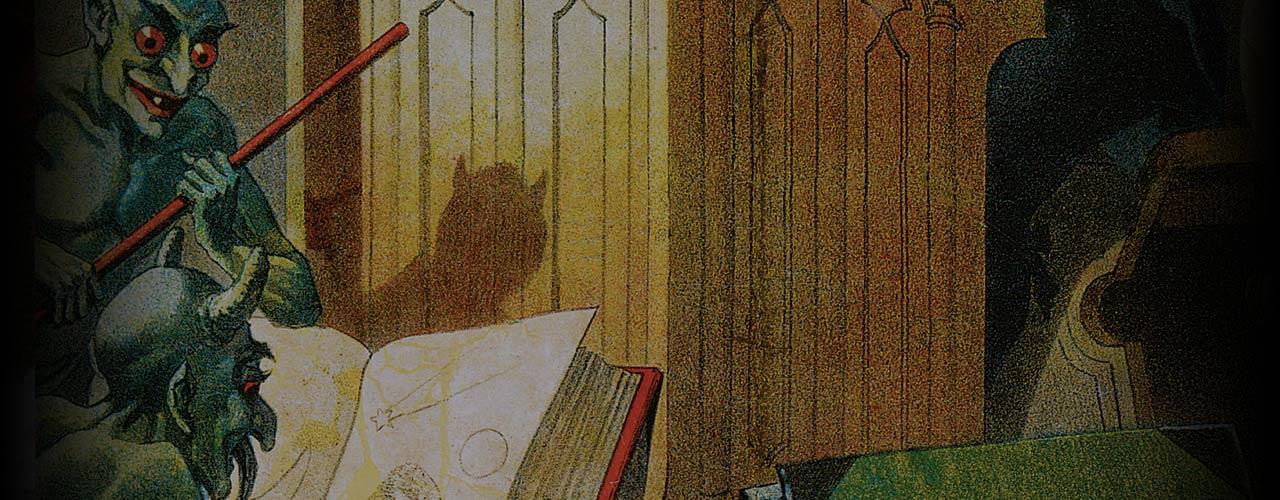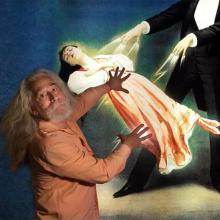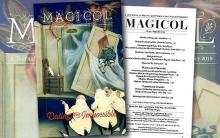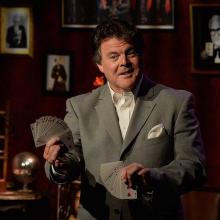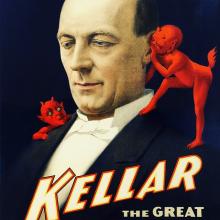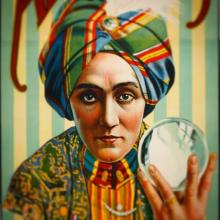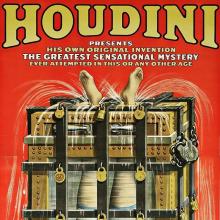Submitted by James Alan on
MUM Magazine | June 2006
By Stephen Minch
Concerning biographies written for the public, and then those written more specifically for the consumption of magicians, no subject has received more attention than Harry Houdini. In magic’s literature, the next three most popular personalities, though distant contenders to H. H., are Robert-Houdin, Dante, and Thurston. Within the past fourteen years, however, another magician has taken second place to the escape king on public shelves and is inching up on the Father of Modern Magic and two of his sons in magic libraries. Surprisingly, he is not a stage performer, but rather a magician who performed mainly close-up magic, and relatively little for the public: Dai Vernon.
The first attempt to chronicle Vernon’s life at book length was Cervon and Burns’s He Fooled Houdini: Dai Vernon, a Magical Life (1992), which relied almost entirely on transcripts of a lengthy taped interview of Vernon by Richard Buffum. The result was a fascinating read, but one based on Vernon’s remarkable yet human memory of the facts. For some years it looked as if that would be where the story would rest. Then, quite unexpectedly, two books deeply concerned with the Vernon saga appeared in bookstores across Great Britain and North America. The first was Phantoms of the Card Table by David Britland and Gazzo (2003), which chronicled the story of the fight for “the crown” of Best American Cardman, between two unintentional contenders, Dai Vernon and Walter Scott. Two years later came Karl Johnson’s The Magician and the Cardsharp, centered on another incident in Vernon’s life, his odyssey in search of Allen Kennedy and the center deal. Both these highly readable volumes, along the way, provide biographies of Vernon giving far wider coverage than the core stories on which the tales are mounted. Those, though, who knew Vernon and the lore that accreted around his long life, understood that there was a great deal more to tell and evaluate than these three books had managed. But who would have the drive and tenacity to tackle a fully researched biography of Vernon’s extraordinary life, spanning a very full ninety-eight years?
Word has been circulating that David Ben, Canada’s premier magician, had accepted the challenge. For roughly seven years, Ben has been intensely involved in researching the life of his countryman, with the intention of doing an in-depth biography, something that promised to exceed all previous Vernonana and to create a benchmark difficult to surpass. Anyone knowing David Ben realizes that when he sets a task for himself, his studies are deep, thorough, intelligent and insightful. When taking on a topic with a complexity, importance and lifespan as great as that of Dai Vernon, such dedication is required to do the subject justice; for chronicling Vernon’s life is in essence chronicling the history of North American close-up magic for the best part of the twentieth century. The two are entwined to such an extent the strands cannot be separated. To paraphrase Salvador Dali’s comment on surrealism, Vernon was not a close-up magician—he was close-up magic. For the best part of a century. One might almost say that if anything important happened in the field, if he wasn’t at the center of it, he in some way influenced it. The story of such a life is a daunting task, one requiring a commitment almost as fanatic in approach as its subject’s was to magic.
David Ben, luckily for us, is the right man. He has amassed an extraordinary compilation of resources on Vernon and his life, having collected data from hundreds of sources, print and visual. He has earned the cooperation of the Verner family, including Vernon’s two sons. He has gained access to correspondence in private collections, some of which has never been penetrated by another researcher. And he can draw on resources few if any knew existed, such as Jeanne Vernon’s unpublished and unvarnished memoir of her life and marriage with her celebrated husband.
The success of a biography is measured in two ways: in depth of research and in portrayal of personality. When one is finished reading a biography, one should not only feel a sense of history but also of the human being. How does Dai Vernon: a Biography measure up? In research, second to none. Only Karl Johnson’s fine study of Vernon, The Magician and the Cardsharp, can claim to be an equal, in its narrower and deliberately focused approach. As a picture of the man, the far more difficult task, the measure can have more than a touch of the subjective to it, and my opinion will not escape this pitfall. My feeling is that Mr. Ben has not filled the cup completely in this first volume of a two-volume work; but the level isn’t far from the brim, and his success greater than most biographies inside magic or out. The element that might have made the effort complete would have been a solid personal acquaintance with Vernon, which Ben does not possess, his meetings with Vernon having been brief. It can be argued, though, that most biographers are forced to work under this handicap. David has compensated for his lack of personal contact through the extensive use of personal correspondence and video and audio records. And, in fairness, I’ll repeat, I am making this assessment on only half a work….
For this first volume of Dai Vernon: a Biography starts and ends with Vernon’s awakening in Bellevue Hospital with both arms broken and doctors asking permission to amputate, after the forty-seven-year-old Vernon had bounced off girders during a six-story fall into the freezing waters of New York’s East River. The book covers Vernon’s life from 1894 through 1941. In so doing, Ben vividly sketches in the times and the general condition of magic during them, the macrocosm into which David Wingfield Verner was squeezed forth, first from a father’s contractions and then from a mother’s, into the world and drifted brilliantly, luckily and carelessly through it.
Ben’s recounting is as engaging as it is informed, making Dai Vernon: A Biography an intensely interesting story, in which we are introduced not just to Vernon, but to a throng of greater and lesser deities from the twentieth century’s pantheon of magic; most notably T. Nelson Downs, Sam Margules, Max Malini, Eddie McGuire, Paul Fox and Faucett Ross. It would be both superficial and unfair to try to summarize even the highlights of this biography. Let it just be said that, thanks to David Ben’s sterling research, no matter how knowledgeable you may be, you will find fascinating and surprising stories, and details to stories, that have not appeared elsewhere. Here is a mere smattering: a solution to the mystery of the Canadian edition of Erdnase from Vernon’s childhood for which no record has been found; the originator of the All Backs routine (it is not Jean Hugard) and quite likely of the rear palm; details of Vernon’s relationship with Malini and the reason for its dissolution; the story behind the Vernon-Hull controversy over Hull’s “Mental Discernment”; the most complete recounting yet of Vernon’s performance of “The Trick That Fooled Houdini”; an intriguing speculation of hoax enmeshed in the Walter Scott imbroglio (which adds a new dimension to the story as told by Britland and Gazzo); the implanting of Vernon’s magic into the works of Hilliard, Hugard and others, without credit; the real history of Vernon’s famous Harlequin stage act (much more of an artistic and commercial success than is frequently reported) and its lesser known successor, performed by Dai Yan and Dr. Chung.
This history is not a hagiography. Ben does not flinch from exposing Vernon’s faults. In fact, they are represented in roughly equal proportion with his strengths. As Ben observes, most geniuses are flawed human beings. Vernon fits the mold. In these early years, anyone and anything that tried to get in the way of his breezing through life with only two concerns, enjoying himself and his obsessive study of close-up magic, was going to be injured.
Ben’s is a tale of both great triumphs and sad failures, and Dai Vernon: a Biography is the story of a truly remarkable man and his times. Supplementing the biography are end notes, a lengthy bibliography of sources and an index. Gabe Fajuri’s Squash Publications has dressed it all in a handsome format, with an attractive and readable page design, an ample scatter of photos, many unfamiliar and rare, and a color dustwrapper. The book is a compelling read and an example of scholarship that will likely survive as the Vernon biography. It surely ranks among the very best of magic biographies and autobiographies given us to enjoy.
Recommended.

